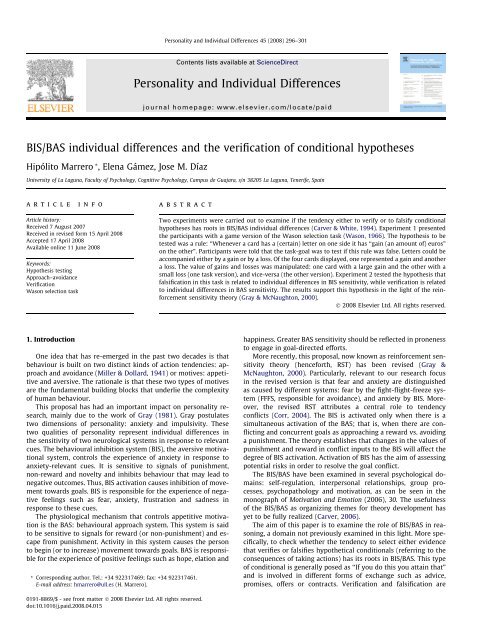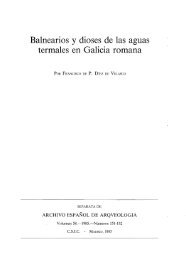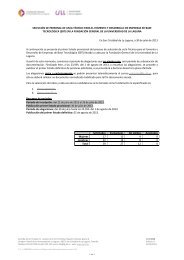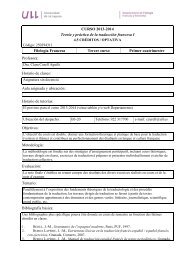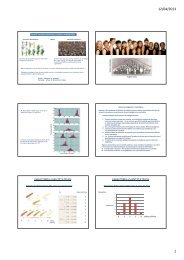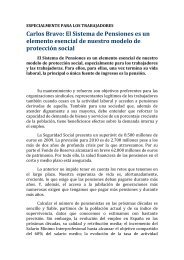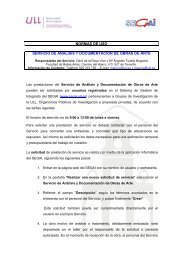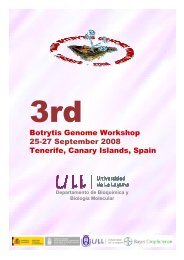BIS/BAS individual differences and the verification of conditional ...
BIS/BAS individual differences and the verification of conditional ...
BIS/BAS individual differences and the verification of conditional ...
Create successful ePaper yourself
Turn your PDF publications into a flip-book with our unique Google optimized e-Paper software.
Personality <strong>and</strong> Individual Differences 45 (2008) 296–301Contents lists available at ScienceDirectPersonality <strong>and</strong> Individual Differencesjournal homepage: www.elsevier.com/locate/paid<strong>BIS</strong>/<strong>BAS</strong> <strong>individual</strong> <strong>differences</strong> <strong>and</strong> <strong>the</strong> <strong>verification</strong> <strong>of</strong> <strong>conditional</strong> hypo<strong>the</strong>sesHipólito Marrero * , Elena Gámez, Jose M. DíazUniversity <strong>of</strong> La Laguna, Faculty <strong>of</strong> Psychology, Cognitive Psychology, Campus de Guajara, s/n 38205 La Laguna, Tenerife, SpainarticleinfoabstractArticle history:Received 7 August 2007Received in revised form 15 April 2008Accepted 17 April 2008Available online 11 June 2008Keywords:Hypo<strong>the</strong>sis testingApproach–avoidanceVerificationWason selection taskTwo experiments were carried out to examine if <strong>the</strong> tendency ei<strong>the</strong>r to verify or to falsify <strong>conditional</strong>hypo<strong>the</strong>ses has roots in <strong>BIS</strong>/<strong>BAS</strong> <strong>individual</strong> <strong>differences</strong> (Carver & White, 1994). Experiment 1 presented<strong>the</strong> participants with a game version <strong>of</strong> <strong>the</strong> Wason selection task (Wason, 1966). The hypo<strong>the</strong>sis to betested was a rule: ‘‘Whenever a card has a (certain) letter on one side it has ‘‘gain (an amount <strong>of</strong>) euros”on <strong>the</strong> o<strong>the</strong>r”. Participants were told that <strong>the</strong> task-goal was to test if this rule was false. Letters could beaccompanied ei<strong>the</strong>r by a gain or by a loss. Of <strong>the</strong> four cards displayed, one represented a gain <strong>and</strong> ano<strong>the</strong>ra loss. The value <strong>of</strong> gains <strong>and</strong> losses was manipulated: one card with a large gain <strong>and</strong> <strong>the</strong> o<strong>the</strong>r with asmall loss (one task version), <strong>and</strong> vice-versa (<strong>the</strong> o<strong>the</strong>r version). Experiment 2 tested <strong>the</strong> hypo<strong>the</strong>sis thatfalsification in this task is related to <strong>individual</strong> <strong>differences</strong> in <strong>BIS</strong> sensitivity, while <strong>verification</strong> is relatedto <strong>individual</strong> <strong>differences</strong> in <strong>BAS</strong> sensitivity. The results support this hypo<strong>the</strong>sis in <strong>the</strong> light <strong>of</strong> <strong>the</strong> reinforcementsensitivity <strong>the</strong>ory (Gray & McNaughton, 2000).Ó 2008 Elsevier Ltd. All rights reserved.1. IntroductionOne idea that has re-emerged in <strong>the</strong> past two decades is thatbehaviour is built on two distinct kinds <strong>of</strong> action tendencies: approach<strong>and</strong> avoidance (Miller & Dollard, 1941) or motives: appetitive<strong>and</strong> aversive. The rationale is that <strong>the</strong>se two types <strong>of</strong> motivesare <strong>the</strong> fundamental building blocks that underlie <strong>the</strong> complexity<strong>of</strong> human behaviour.This proposal has had an important impact on personality research,mainly due to <strong>the</strong> work <strong>of</strong> Gray (1981). Gray postulatestwo dimensions <strong>of</strong> personality: anxiety <strong>and</strong> impulsivity. Thesetwo qualities <strong>of</strong> personality represent <strong>individual</strong> <strong>differences</strong> in<strong>the</strong> sensitivity <strong>of</strong> two neurological systems in response to relevantcues. The behavioural inhibition system (<strong>BIS</strong>), <strong>the</strong> aversive motivationalsystem, controls <strong>the</strong> experience <strong>of</strong> anxiety in response toanxiety-relevant cues. It is sensitive to signals <strong>of</strong> punishment,non-reward <strong>and</strong> novelty <strong>and</strong> inhibits behaviour that may lead tonegative outcomes. Thus, <strong>BIS</strong> activation causes inhibition <strong>of</strong> movementtowards goals. <strong>BIS</strong> is responsible for <strong>the</strong> experience <strong>of</strong> negativefeelings such as fear, anxiety, frustration <strong>and</strong> sadness inresponse to <strong>the</strong>se cues.The physiological mechanism that controls appetitive motivationis <strong>the</strong> <strong>BAS</strong>: behavioural approach system. This system is saidto be sensitive to signals for reward (or non-punishment) <strong>and</strong> escapefrom punishment. Activity in this system causes <strong>the</strong> personto begin (or to increase) movement towards goals. <strong>BAS</strong> is responsiblefor <strong>the</strong> experience <strong>of</strong> positive feelings such as hope, elation <strong>and</strong>* Corresponding author. Tel.: +34 922317469; fax: +34 922317461.E-mail address: hmarrero@ull.es (H. Marrero).happiness. Greater <strong>BAS</strong> sensitivity should be reflected in pronenessto engage in goal-directed efforts.More recently, this proposal, now known as reinforcement sensitivity<strong>the</strong>ory (henceforth, RST) has been revised (Gray &McNaughton, 2000). Particularly, relevant to our research focusin <strong>the</strong> revised version is that fear <strong>and</strong> anxiety are distinguishedas caused by different systems: fear by <strong>the</strong> fight-flight-freeze system(FFFS, responsible for avoidance), <strong>and</strong> anxiety by <strong>BIS</strong>. Moreover,<strong>the</strong> revised RST attributes a central role to tendencyconflicts (Corr, 2004). The <strong>BIS</strong> is activated only when <strong>the</strong>re is asimultaneous activation <strong>of</strong> <strong>the</strong> <strong>BAS</strong>; that is, when <strong>the</strong>re are conflicting<strong>and</strong> concurrent goals as approaching a reward vs. avoidinga punishment. The <strong>the</strong>ory establishes that changes in <strong>the</strong> values <strong>of</strong>punishment <strong>and</strong> reward in conflict inputs to <strong>the</strong> <strong>BIS</strong> will affect <strong>the</strong>degree <strong>of</strong> <strong>BIS</strong> activation. Activation <strong>of</strong> <strong>BIS</strong> has <strong>the</strong> aim <strong>of</strong> assessingpotential risks in order to resolve <strong>the</strong> goal conflict.The <strong>BIS</strong>/<strong>BAS</strong> have been examined in several psychological domains:self-regulation, interpersonal relationships, group processes,psychopathology <strong>and</strong> motivation, as can be seen in <strong>the</strong>monograph <strong>of</strong> Motivation <strong>and</strong> Emotion (2006), 30. The usefulness<strong>of</strong> <strong>the</strong> <strong>BIS</strong>/<strong>BAS</strong> as organizing <strong>the</strong>mes for <strong>the</strong>ory development hasyet to be fully realized (Carver, 2006).The aim <strong>of</strong> this paper is to examine <strong>the</strong> role <strong>of</strong> <strong>BIS</strong>/<strong>BAS</strong> in reasoning,a domain not previously examined in this light. More specifically,to check whe<strong>the</strong>r <strong>the</strong> tendency to select ei<strong>the</strong>r evidencethat verifies or falsifies hypo<strong>the</strong>tical <strong>conditional</strong>s (referring to <strong>the</strong>consequences <strong>of</strong> taking actions) has its roots in <strong>BIS</strong>/<strong>BAS</strong>. This type<strong>of</strong> <strong>conditional</strong> is generally posed as ‘‘If you do this you attain that”<strong>and</strong> is involved in different forms <strong>of</strong> exchange such as advice,promises, <strong>of</strong>fers or contracts. Verification <strong>and</strong> falsification are0191-8869/$ - see front matter Ó 2008 Elsevier Ltd. All rights reserved.doi:10.1016/j.paid.2008.04.015
H. Marrero et al. / Personality <strong>and</strong> Individual Differences 45 (2008) 296–301 297central phenomena for hypo<strong>the</strong>sis-testing research. Verificationhas been shown to be a general bias: people tend to look for evidencethat verifies a previous hypo<strong>the</strong>sis (see Nickerson, 1998).However, falsification is preferred if <strong>the</strong> (hypo<strong>the</strong>tical) <strong>conditional</strong>action ? result refers to social contracts (Cosmides, 1989). Moreover,people are motivated to reject (<strong>and</strong> to falsify) threateningpropositions (Dawson, Gilovich, & Regan, 2002).How could <strong>BIS</strong>/<strong>BAS</strong> affect reasoning in <strong>the</strong> ambit <strong>of</strong> searchingfor evidence to test hypo<strong>the</strong>tical <strong>conditional</strong>s? One possible wayis by biasing <strong>individual</strong>s towards selecting ei<strong>the</strong>r evidence for falsifyingor verifying action ? result <strong>conditional</strong>s. Take <strong>the</strong> example<strong>of</strong> advice; someone tells you that by investing in <strong>the</strong> shares <strong>of</strong>company C, you gain money. This comment constitutes a hypo<strong>the</strong>ticalaction ? result <strong>conditional</strong> (If someone invests in <strong>the</strong>shares <strong>of</strong> company C <strong>the</strong>n he/she gains money) <strong>and</strong> it could be inyour interest to find evidence to check this hypo<strong>the</strong>sis. As aforementioned,<strong>the</strong> <strong>BAS</strong> is sensitive to signals for reward, <strong>and</strong> socauses approach towards behaviour that may lead to rewardingoutcomes. There could be signals <strong>of</strong> a reward following <strong>the</strong> action<strong>of</strong> investing. For example, you are informed that <strong>the</strong> companyis trustworthy in a growing economic sector. In that case,<strong>BAS</strong> leads you to attempt to check <strong>the</strong> sequence action ? reward.That is, to verify <strong>the</strong> action ? result <strong>conditional</strong> by beingsensitive to (or actively looking for) evidence <strong>of</strong>: (a) Personswho have invested in shares <strong>of</strong> company C (Have <strong>the</strong>y gainedmoney?); <strong>and</strong> (b) persons who have gained money (Have <strong>the</strong>yinvested in company C?).Conversely, <strong>the</strong> <strong>BIS</strong> is sensitive to signals <strong>of</strong> punishment (ornon-reward), <strong>and</strong> so causes inhibition towards behaviour thatmay lead to negative outcomes. There could be signals <strong>of</strong> punishmentfollowing <strong>the</strong> action <strong>of</strong> investing; for example, you are informedthat <strong>the</strong> company is untrustworthy. In this case, <strong>BIS</strong> leadsyou to try to check <strong>the</strong> sequence action ? punishment. That is, t<strong>of</strong>alsify <strong>the</strong> action ? result <strong>conditional</strong> by being sensitive to evidence<strong>of</strong>: (a) Persons who have invested in shares <strong>of</strong> company C(Have <strong>the</strong>y lost money?); <strong>and</strong> (b) Persons who have lost money(Have <strong>the</strong>y invested in shares <strong>of</strong> company C?).The bias towards <strong>verification</strong> (in contrast to <strong>the</strong> greater difficulty<strong>of</strong> falsification) has received several explanations. From acognitive perspective, Evans (1989) attributed this to <strong>the</strong> facilityto represent positive instances <strong>of</strong> a certain proposition in contrastto <strong>the</strong> alternative negative ones. From a motivational perspective,Dawson et al. (2002) made <strong>the</strong> proposal that people tend to accept(<strong>and</strong> so to verify) agreeable or neutral propositions, while <strong>the</strong>y aremotivated to reject (<strong>and</strong> so to falsify) disagreeable <strong>and</strong> threateningpropositions. From <strong>the</strong> <strong>BIS</strong>/<strong>BAS</strong> perspective, <strong>the</strong> occurrence <strong>of</strong><strong>verification</strong> versus falsification depends on <strong>the</strong> reward <strong>and</strong> punishmentinvolved in accepting <strong>the</strong> proposition. As previously shown,<strong>the</strong> <strong>conditional</strong> proposition: If someone invests in <strong>the</strong> shares <strong>of</strong>company C <strong>the</strong>n he/she gains money would be verified if <strong>the</strong>probability (<strong>and</strong> value) <strong>of</strong> <strong>the</strong> reward (‘‘gaining money”) is high.In contrast, it would be falsified if what is high is <strong>the</strong> alternativepunishment (‘‘losing money”). In contrast to <strong>the</strong> motivational<strong>and</strong> cognitive approaches, nei<strong>the</strong>r <strong>the</strong> agreeability <strong>of</strong> <strong>the</strong> propositionnor <strong>the</strong> cognitive scenario has changed when <strong>verification</strong> orfalsification occur.The Wason selection task (Wason, 1966) is a useful tool in research<strong>of</strong> <strong>the</strong> cognitive processes involved in verifying/falsifying<strong>conditional</strong> rules or hypo<strong>the</strong>ses by checking partial evidence ei<strong>the</strong>rin epistemic (Evans, 1998) or social contexts (Cosmides, 1989).The original task is a paper-<strong>and</strong>-pencil problem that invitessubjects to check whe<strong>the</strong>r a hypo<strong>the</strong>tical <strong>conditional</strong> rule <strong>of</strong> <strong>the</strong>type ‘‘if p <strong>the</strong>n q” is true or false as follows (see Fig. 1).The usual selection, about 45% <strong>of</strong> <strong>the</strong> time, is that <strong>of</strong> cards ‘‘A”(<strong>the</strong> ‘‘p” card) <strong>and</strong> ‘‘4” (<strong>the</strong> ‘‘q” card), which is a confirmatory selection(see Nickerson, 1998). The falsifying selection <strong>of</strong> turning overcard ‘‘A” (<strong>the</strong> ‘‘p” card: to see if it has a seven on <strong>the</strong> o<strong>the</strong>r side) <strong>and</strong>card ‘‘seven” (<strong>the</strong> ‘‘not-q” card: to see if it has an A on <strong>the</strong> o<strong>the</strong>rside) is infrequent (less than 10%).It has been demonstrated that <strong>verification</strong> <strong>and</strong> falsificationstrategies in this task are induced by <strong>the</strong> type <strong>of</strong> content, <strong>the</strong> taskcontext <strong>and</strong> instructions (see Evans, 1998). However, as far as weknow, <strong>the</strong> role <strong>of</strong> <strong>BIS</strong>/<strong>BAS</strong> has not been examined.Here we adapt <strong>the</strong> Wason selection task <strong>and</strong> directly focus onexamining <strong>the</strong> role <strong>of</strong> <strong>BIS</strong>/<strong>BAS</strong> in orientating <strong>individual</strong>s towardsei<strong>the</strong>r <strong>the</strong> falsification or <strong>verification</strong> <strong>of</strong> contextual <strong>and</strong> hypo<strong>the</strong>ticalaction ? result <strong>conditional</strong>s.2. Study 1Fig. 1. The original Wason selection task.We presented <strong>the</strong> participants with a game version <strong>of</strong> <strong>the</strong> Selectiontask elaborated by <strong>the</strong> authors. The hypo<strong>the</strong>sis to be checkedwas a rule: ‘‘Whenever a card has a (certain) letter on one side ithas ‘‘gain (an amount <strong>of</strong>) euros” on <strong>the</strong> o<strong>the</strong>r”. Letters could beaccompanied ei<strong>the</strong>r by a gain or by a loss. Of <strong>the</strong> four cards displayed,one represented a gain <strong>and</strong> <strong>the</strong> o<strong>the</strong>r a loss. The value <strong>of</strong>gains <strong>and</strong> losses was manipulated: one card with a large gain<strong>and</strong> <strong>the</strong> o<strong>the</strong>r with a small loss in one task version, <strong>and</strong> vice-versa,one card with a small gain <strong>and</strong> <strong>the</strong> o<strong>the</strong>r with a large loss, in <strong>the</strong>o<strong>the</strong>r version. Participants were told that <strong>the</strong> task-goal was tocheck in a free-cost test whe<strong>the</strong>r <strong>the</strong> rule was false in order toavoid <strong>the</strong> loss (see Appendix A).As aforementioned, <strong>the</strong> revised RST attributes a central role totendency conflicts. Here <strong>the</strong>re is a conflict between attaining a reward(<strong>the</strong> gain) <strong>and</strong> avoiding a punishment (<strong>the</strong> loss). Accordingto Corr (2002), <strong>the</strong> conflict between <strong>the</strong> reward <strong>and</strong> punishmentis resolved by <strong>the</strong> decision mechanism depending on which inputto this mechanism is stronger. Therefore, activation <strong>of</strong> <strong>BAS</strong> wouldpredominate when a great reward is involved. Conversely, activation<strong>of</strong> <strong>BIS</strong> would predominate if a great punishment (in contrastto a small reward) is involved. Therefore, our predictions werethat participants will tend to verify <strong>the</strong> <strong>conditional</strong> rule in <strong>the</strong>condition ‘‘large gain/ small loss” <strong>and</strong> solve <strong>the</strong> task by concludingthat <strong>the</strong> rule is false if it is not true. In this task version, <strong>BAS</strong>would lead subjects to check <strong>the</strong> sequence action ? reward (<strong>the</strong>large gain), that is, to check if <strong>the</strong> letter A is followed by <strong>the</strong> gain<strong>and</strong> <strong>the</strong> gain card is preceded by <strong>the</strong> letter A. In contrast, we predictthat subjects will tend to falsify <strong>the</strong> rule in <strong>the</strong> condition‘‘small gain/large loss” <strong>and</strong> solve <strong>the</strong> task by directly consideringif <strong>the</strong> rule is false. In this version, <strong>BIS</strong> leads subjects to check<strong>the</strong> sequence action ? punishment (<strong>the</strong> large loss), that is, to checkif <strong>the</strong> letter A is followed by <strong>the</strong> loss <strong>and</strong> <strong>the</strong> loss card is precededby <strong>the</strong> letter A.
298 H. Marrero et al. / Personality <strong>and</strong> Individual Differences 45 (2008) 296–3012.1. Method2.1.1. ParticipantsOne hundred twenty-seven students from <strong>the</strong> University <strong>of</strong> LaLaguna participated in this experiment in exchange for coursecredit. Their ages ranged from 18 to 27. Thirty-seven were male.2.1.2. Design <strong>and</strong> procedureThe design had one between-subject factor, <strong>the</strong> gain/loss valuedisplayed in <strong>the</strong> cards with two conditions: Large gain/small loss<strong>and</strong> small gain/large loss. Two dependent variables were used.One was ‘‘Loss card selection”, <strong>the</strong> result <strong>of</strong> adding <strong>the</strong> followingselections: letter A <strong>and</strong> <strong>the</strong> loss card, letter Y <strong>and</strong> <strong>the</strong> loss card,<strong>and</strong> <strong>the</strong> loss card alone. The o<strong>the</strong>r was ‘‘Gain card selection”, <strong>the</strong> result<strong>of</strong> adding <strong>the</strong> selections: letter A <strong>and</strong> <strong>the</strong> gain card, letter Y <strong>and</strong><strong>the</strong> gain card, <strong>and</strong> <strong>the</strong> gain card alone.Seventy subjects were assigned to <strong>the</strong> ‘‘small gain/large loss”<strong>and</strong> 57 subjects to <strong>the</strong> ‘‘large gain/small loss” conditions. Thetwo task versions were r<strong>and</strong>omly given out to <strong>the</strong> students duringregular class without a time limit in a quiet environment.The proportion <strong>of</strong> male participants was similar in <strong>the</strong>conditions.2.2. ResultsAs expected, participants selected <strong>the</strong> gain card (49%) morethan <strong>the</strong> loss card (26%) significantly in <strong>the</strong> condition large gain/small loss, v 2 (1) = 6.32, p < .05. In contrast, <strong>the</strong> gain <strong>and</strong> loss cardswere equally selected in <strong>the</strong> condition small gain/large loss (42%).If we consider <strong>the</strong> gain card selection, <strong>the</strong>re was no significanteffect between <strong>the</strong> large gain/small loss (49%) <strong>and</strong> <strong>the</strong> smallgain/large loss (42%) conditions, v 2 (1) = 0.63, p > .20. In <strong>the</strong> case<strong>of</strong> <strong>the</strong> loss card selection, participants selected <strong>the</strong> loss card morein <strong>the</strong> condition small gain/large loss (42%) than in <strong>the</strong> conditionlarge gain/small loss (26%), in a marginally significant way, v 2(1) = 3.39, p < .10.It was relevant that participants who selected <strong>the</strong> ‘‘gain card”tended to justify <strong>the</strong>ir decision as aimed ei<strong>the</strong>r at confirming ornot <strong>the</strong> rule; for example: ‘‘I selected <strong>the</strong> cards A <strong>and</strong> 100 € gain becauseon <strong>the</strong> o<strong>the</strong>r side <strong>of</strong> <strong>the</strong> card A you can find ei<strong>the</strong>r 100 € gainor 1 € loss. Likewise, on <strong>the</strong> o<strong>the</strong>r side <strong>of</strong> <strong>the</strong> card 100 € gain youcan find <strong>the</strong> letter A or ano<strong>the</strong>r letter.” In contrast, participantswho selected <strong>the</strong> loss card tended to justify <strong>the</strong>ir decision as aimedat directly falsifying <strong>the</strong> rule; for example... ‘‘I selected card A becauseI have to know if on <strong>the</strong> o<strong>the</strong>r side <strong>of</strong> this card <strong>the</strong>re is a 100 €loss, <strong>and</strong> card 100 € loss because if <strong>the</strong> letter A is on <strong>the</strong> o<strong>the</strong>r side, Iwill not play, I’ll pass.”These results give some support to our main predictions.Participants tended to verify <strong>the</strong> <strong>conditional</strong> rule by selecting <strong>the</strong>gain card if <strong>the</strong>re was a large gain. Conversely, participants tendedto falsify <strong>the</strong> <strong>conditional</strong> rule by selecting <strong>the</strong> loss card if <strong>the</strong>re wasa large loss in contrast to a small gain.However, <strong>the</strong> absence <strong>of</strong> more robust statistical effects in <strong>the</strong>type <strong>of</strong> selection made in <strong>the</strong> two experimental conditions suggeststhat <strong>the</strong>re could have been an influence <strong>of</strong> <strong>individual</strong>variability. Participants could have differed in <strong>the</strong>ir sensitivitiesto reward (gain) <strong>and</strong> to punishment (loss), <strong>and</strong> this variabilitycould have weakened <strong>the</strong> experimental effects. The aim <strong>of</strong> Experiment2 was to examine <strong>the</strong> role <strong>of</strong> <strong>individual</strong> <strong>differences</strong> in <strong>BIS</strong>/<strong>BAS</strong>sensitivities in <strong>the</strong> card selection.3. Study 2The revised RST establishes that changes in <strong>the</strong> values <strong>of</strong>punishment <strong>and</strong> reward in conflict inputs to <strong>the</strong> <strong>BIS</strong> will affect<strong>the</strong> degree <strong>of</strong> <strong>BIS</strong> activation. Moreover, both reward <strong>and</strong> punishmentsensitivities will determine whe<strong>the</strong>r a conflict is detected<strong>and</strong> to what extent (Corr, 2004). Thus, we predicted that high<strong>BAS</strong> subjects will tend to verify <strong>the</strong> <strong>conditional</strong> rule by selecting<strong>the</strong> gain card in <strong>the</strong> condition ‘‘large gain/small loss”. As <strong>the</strong>y willbe sensitive to <strong>the</strong> greater value <strong>of</strong> reward, <strong>the</strong>y will tend not to detect<strong>the</strong> conflict <strong>and</strong> will check <strong>the</strong> sequence letter A ? gain card,that is, <strong>the</strong> sequence action ? reward. In contrast, high <strong>BIS</strong> subjectswill tend to falsify <strong>the</strong> <strong>conditional</strong> rule by selecting <strong>the</strong> loss card in<strong>the</strong> condition ‘‘small gain/large loss”. As <strong>the</strong>y will be sensitive to<strong>the</strong> greater value <strong>of</strong> punishment, <strong>the</strong>y will tend to detect <strong>the</strong> conflict<strong>and</strong> will check <strong>the</strong> sequence letter A ? loss card, that is,action ? punishment.Also relevant to our research is to examine whe<strong>the</strong>r punishment<strong>and</strong> reward sensitivities act as separable or joint subsystems,as <strong>the</strong> precise pattern <strong>of</strong> personality effects ishypo<strong>the</strong>sised to depend upon this (Corr, 2002). If <strong>the</strong>y act asseparable, <strong>BIS</strong> facilitates <strong>BIS</strong>-mediating conducts <strong>and</strong> <strong>BAS</strong> facilitates<strong>BAS</strong>-mediating conducts <strong>and</strong> mutual inhibition occurs. Incontrast, if <strong>the</strong>y act as joint subsystems, antagonism could beexpected with <strong>BIS</strong> impairing <strong>BAS</strong> mediated behaviour, <strong>and</strong> <strong>BAS</strong>impairing <strong>BIS</strong> mediated behaviour. Situations that contain mixedreward <strong>and</strong> punishment cues are hypo<strong>the</strong>sised to facilitate jointsubsystem activity. As <strong>the</strong>re are mixed cues <strong>of</strong> reward <strong>and</strong> punishmentin <strong>the</strong> game task, we adopt <strong>the</strong> joint subsystem hypo<strong>the</strong>sis.This predicts that appetitive (verifying) responses in <strong>the</strong>game task should be highest in <strong>individual</strong>s high in <strong>BAS</strong> but lowin <strong>BIS</strong>. Conversely, aversive (falsifying) responses should be highestin <strong>individual</strong>s high in <strong>BIS</strong> but low in <strong>BAS</strong>.3.1. Method3.1.1. ParticipantsOne hundred thirty-nine students from <strong>the</strong> University <strong>of</strong> La Laguna.Ages ranged from 18 to 29. Thirty-nine were males.3.1.2. Measures<strong>BIS</strong>/<strong>BAS</strong>. There are different <strong>BIS</strong>/<strong>BAS</strong> measures (Carver & White,1994; Caseras, Ávila, & Torrubia, 2003). We use <strong>the</strong> Carver <strong>and</strong>White scales that have been reported as useful in several studies(see Carver, 2006). The scales are a 20-item, four-point Likert-typemeasure composed <strong>of</strong> <strong>the</strong> following four subscales: <strong>BIS</strong>, withitems that reflect concern <strong>and</strong> fear about <strong>the</strong> possibility <strong>of</strong> a badoccurrence, or sensitivity to occurrence, <strong>BAS</strong>-reward responsiveness(<strong>BAS</strong>-RR) items reflect responsiveness to reward, <strong>BAS</strong>-drive(<strong>BAS</strong>-D) relates to <strong>the</strong> tendency to act quickly <strong>and</strong> strongly in pursuit<strong>of</strong> appetitive goals, <strong>and</strong> <strong>BAS</strong>-fun seeking (<strong>BAS</strong>-FS) refers to <strong>the</strong>tendency to seek out new potentially rewarding experiences.Respondents are asked to rate <strong>the</strong> extent <strong>of</strong> <strong>the</strong>ir agreement, from1 (strongly disagree) to4(strongly agree). Internal consistencies <strong>of</strong><strong>the</strong> scales ranged from good to excellent, <strong>and</strong> test–retest reliability,convergent <strong>and</strong> divergent as well as factorial validity weresatisfactory in <strong>the</strong> studies <strong>of</strong> Carver <strong>and</strong> White. Fur<strong>the</strong>r researchhas confirmed <strong>the</strong>ir st<strong>and</strong>ard as <strong>BIS</strong>/<strong>BAS</strong> measures (Carver,2006; Caseras, Ávila, & Torrubia, 2003). In <strong>the</strong> current study, <strong>the</strong>sample had alpha values <strong>BIS</strong>: .81, <strong>BAS</strong>-RR: .88, <strong>BAS</strong>-D: .52 <strong>and</strong><strong>BAS</strong>-FS: .57. These values are all acceptable, especially those <strong>of</strong><strong>BIS</strong> <strong>and</strong> <strong>BAS</strong>-RR.3.1.3. Design <strong>and</strong> procedureThe same as in Experiment 1, 70 participants in <strong>the</strong> ‘‘small gain/large loss” <strong>and</strong> 69 participants in <strong>the</strong> ‘‘large gain/small loss” conditions.Their scores in <strong>BIS</strong>/<strong>BAS</strong> scales were taken from a battery previouslypassed.
H. Marrero et al. / Personality <strong>and</strong> Individual Differences 45 (2008) 296–301 2993.2. Results3.2.1. <strong>BIS</strong>/<strong>BAS</strong> prediction <strong>of</strong> <strong>the</strong> type <strong>of</strong> selectionWe carried out linear multiple regression analyses in each conditionwith <strong>BIS</strong>/<strong>BAS</strong> scales as predictive variables <strong>and</strong> type <strong>of</strong> selectionas <strong>the</strong> criterion. To enable this analysis, we assigned value 1 to<strong>the</strong> gain card selection <strong>and</strong> 1 to <strong>the</strong> loss card selection. So positivebeta values indicate <strong>the</strong> relation <strong>of</strong> a given scale to verifying <strong>the</strong>rule (selecting <strong>the</strong> gain card) <strong>and</strong> negative values indicate <strong>the</strong> relation<strong>of</strong> <strong>the</strong> scale to falsifying <strong>the</strong> rule (selecting <strong>the</strong> loss card). Participantswho did not select ei<strong>the</strong>r <strong>of</strong> <strong>the</strong>se cards were removedfrom <strong>the</strong> analysis (11%). In addition, we decomposed <strong>the</strong> <strong>BIS</strong> scale.As aforementioned, anxiety <strong>and</strong> fear are different emotions in <strong>the</strong>revised RST. There is some empirical evidence that supports thisfunctional distinction (see Perkins, Kemp, & Corr, 2007). The <strong>BIS</strong>scale was differentiated by two subscales: <strong>BIS</strong>-fear composed <strong>of</strong><strong>the</strong> two fear items <strong>of</strong> <strong>the</strong> original scale <strong>and</strong> <strong>BIS</strong>-anxiety scale by<strong>the</strong> o<strong>the</strong>r <strong>BIS</strong>-items. We adopt this procedure following Corr <strong>and</strong>McNaughton (2008).In order to carry out <strong>the</strong> regression analysis we firstly force <strong>the</strong><strong>BIS</strong> <strong>and</strong> <strong>BAS</strong> scale (<strong>the</strong> result <strong>of</strong> adding <strong>the</strong> scores <strong>of</strong> <strong>the</strong> three <strong>BAS</strong>subscales),<strong>and</strong> subsequently we introduce <strong>the</strong> <strong>BAS</strong> <strong>and</strong> <strong>BIS</strong> subscalesstepwise.In <strong>the</strong> large gain/small loss condition, <strong>the</strong> <strong>BIS</strong>/<strong>BAS</strong> scales predict16% <strong>of</strong> <strong>the</strong> variance. The model <strong>of</strong> regression was significant, F(2,57) = 5.53, p = 0.006. The <strong>BAS</strong> scale was <strong>the</strong> only significant predictor(Table 1). In accordance with our predictions, <strong>individual</strong>swith high <strong>BAS</strong> tended to select <strong>the</strong> gain card (<strong>the</strong> reward) <strong>and</strong> soto verify <strong>the</strong> rule in this condition. By stepwise, only <strong>the</strong> <strong>BAS</strong>-rewardresponsiveness was significant <strong>and</strong> predicted 13% <strong>of</strong> <strong>the</strong>variance. The model <strong>of</strong> regression was significant, F (1,58) = 8.49,p = 0.005. In a discriminative way, <strong>the</strong> <strong>BAS</strong>-RR was <strong>the</strong> strongestpredictor <strong>of</strong> <strong>the</strong> gain card (reward) selection.In <strong>the</strong> small gain/large loss condition, <strong>the</strong> <strong>BIS</strong>/<strong>BAS</strong> scales predicted8% <strong>of</strong> <strong>the</strong> variance. The model <strong>of</strong> regression was marginallysignificant, F (2,61) = 2.65, p = 0.07. Only <strong>the</strong> influence <strong>of</strong> <strong>BIS</strong>-scalewas significant (Table 1). In accordance with our predictions, high<strong>BIS</strong> <strong>individual</strong>s tended to select <strong>the</strong> loss card (<strong>the</strong> punishment). Bystepwise, only <strong>the</strong> <strong>BIS</strong>-fear subscale was significant (Table 1) <strong>and</strong>predicted 22% <strong>of</strong> <strong>the</strong> variance. The model <strong>of</strong> regression wassignificant, F (1,62) = 17.21, p = 0.000. It is worthy <strong>of</strong> note that<strong>BIS</strong>-fear predicted a lot more <strong>the</strong> conduct <strong>of</strong> selecting <strong>the</strong> loss card(punishment) than <strong>the</strong> whole <strong>BIS</strong>-scale (<strong>and</strong> so <strong>the</strong> <strong>BIS</strong>-anxiety).3.2.2. Joint or separable <strong>BIS</strong>/<strong>BAS</strong> subsystems?We carried out several analyses <strong>of</strong> variance with <strong>the</strong> type <strong>of</strong>selection as dependent variable. One way ANOVA with (mediansplit)<strong>BIS</strong> (3.14) <strong>and</strong> <strong>BAS</strong> (3.07) as <strong>the</strong> between-subject factorswas carried out. The main effect <strong>of</strong> <strong>BAS</strong> was marginally significant,F (3,120) = 3.44, p = 0.06 while <strong>the</strong> main effect <strong>of</strong> <strong>BIS</strong> was significant,F (3,120) = 8.00, p = 0.005. The effect <strong>of</strong> <strong>BIS</strong> * <strong>BAS</strong> interactionwas not significant, p < .20.It is evident from Fig. 2 that appetitive responses towardsselecting <strong>the</strong> gain card were highest in <strong>individual</strong>s high in <strong>BAS</strong>but low in <strong>BIS</strong> (third column). Conversely, aversive responses towardsselecting <strong>the</strong> loss card were highest in <strong>individual</strong>s high in<strong>BIS</strong> but low in <strong>BAS</strong> (second column). This difference (0.765) wassignificant, t (52) = 3.19, p = 0.002.We now examine if influence <strong>of</strong> <strong>BIS</strong>/<strong>BAS</strong> personality traitschanges as a function <strong>of</strong> <strong>the</strong> values <strong>of</strong> reward <strong>and</strong> punishment involvedin <strong>the</strong> experimental conditions. It is evident from <strong>the</strong>Fig. 2. Mean type <strong>of</strong> selection for (median-split) low ( ) <strong>and</strong> high (+) <strong>BIS</strong> <strong>and</strong> <strong>BAS</strong>groups (bars = st<strong>and</strong>ard error <strong>of</strong> <strong>the</strong> mean).Table 1Multiple linear regression values <strong>of</strong> <strong>the</strong> predictive variables<strong>BIS</strong>/<strong>BAS</strong> scales b t p R 2 (%)Large gain/small loss<strong>BAS</strong> 0.366 2.96 0.004 16<strong>BIS</strong> 0.114 0.93 0.358By stepwise: 13<strong>BAS</strong>-reward responsiveness 0.358 2.91 0.005Excluded:<strong>BAS</strong>-drive 0.130 1.03 0.307<strong>BAS</strong>-fun 0.242 1.99 0.052<strong>BIS</strong>-fear 0.190 1.56 0.120<strong>BIS</strong>-anxiety 0.173 1.40 0.170Small gain/large loss<strong>BAS</strong> 0.108 0.680 0.499 08<strong>BIS</strong> 0.338 2.140 0.037By stepwise: 22<strong>BIS</strong>-fear 0.466 4.15 0.000Excluded:<strong>BAS</strong>-drive 0.140 1.24 0.157<strong>BAS</strong>-fun 0.054 0.477 0.635<strong>BAS</strong>-reward responsiveness 0.110 0.090 0.930<strong>BIS</strong>-anxiety 0.092 0.700 0.487Fig. 3. Mean type <strong>of</strong> selection for (median-split) low ( ) <strong>and</strong> high (+) <strong>BIS</strong> <strong>and</strong> <strong>BAS</strong>groups in large gain/small loss <strong>and</strong> <strong>the</strong> small gain/large loss conditions (bars = st<strong>and</strong>arderror <strong>of</strong> <strong>the</strong> mean).
300 H. Marrero et al. / Personality <strong>and</strong> Individual Differences 45 (2008) 296–301contrast in Fig. 3 that only <strong>the</strong> group <strong>BAS</strong>(+)/<strong>BIS</strong>(+) has visiblychanged among <strong>the</strong> two conditions.In this group <strong>the</strong>re are more appetitive responses (gain cardselection) in <strong>the</strong> large gain/small loss condition (47%) than in smallgain/large loss condition (8%), although this difference did notreach significance, p = 0.26.4. General discussionIn accordance with RST predictions, our results have shown thatchanges in <strong>the</strong> values <strong>of</strong> reward <strong>and</strong> punishment in interactionwith <strong>individual</strong> variability in sensitivity to reward <strong>and</strong> punishmentinduced ei<strong>the</strong>r <strong>verification</strong> or falsification in <strong>the</strong> game task. Alsorelevant, <strong>the</strong> greater percentage <strong>of</strong> appetitive (verifying) responses– selecting <strong>the</strong> gain – was given by <strong>individual</strong>s high in <strong>BAS</strong> but lowin <strong>BIS</strong>. Conversely, <strong>the</strong> greater percentage <strong>of</strong> aversive (falsifying)responses – selecting <strong>the</strong> loss – was given by <strong>individual</strong>s high in<strong>BIS</strong> but low in <strong>BAS</strong>. In addition, our results have indicated thatwhen <strong>the</strong> value <strong>of</strong> <strong>the</strong> loss (punishment) is high, <strong>BIS</strong> inhibits impulsivitytowards selecting <strong>the</strong> gain card (reward) in high <strong>BAS</strong> participants.This pattern <strong>of</strong> results supports <strong>the</strong> joint subsystemshypo<strong>the</strong>sis (Corr, 2002).Our results also indicate that <strong>the</strong> functional distinction betweenanxiety <strong>and</strong> fear is appropriate to examine <strong>the</strong> role <strong>of</strong> <strong>individual</strong><strong>differences</strong> in punishment sensitivity in selection behaviour. Inour game task <strong>the</strong>re was an approach–avoidance conflict <strong>of</strong> attaining<strong>the</strong> reward (<strong>the</strong> gain) <strong>and</strong> avoiding <strong>the</strong> punishment (<strong>the</strong> loss).In this context, participants high in fearfulness to potential punishmentwill experience <strong>the</strong> task in <strong>the</strong> small gain/large loss conditionas <strong>the</strong> origin <strong>of</strong> an approach–avoidance conflict, <strong>and</strong> motivated by<strong>BIS</strong>, will tend to inspect <strong>the</strong> loss card (<strong>the</strong> risk <strong>of</strong> loss). In contrast,participants low in fearfulness (in <strong>the</strong> pursuit <strong>of</strong> a reward) willtend to ignore punishment, <strong>and</strong> to minimize this conflict. As a result,<strong>BIS</strong> is not triggered <strong>and</strong> <strong>BAS</strong> would lead <strong>the</strong>m to select <strong>the</strong> gaincard (reward).In this light, we consider that fur<strong>the</strong>r research is necessary toexamine <strong>the</strong> role <strong>of</strong> fearfulness in <strong>individual</strong> <strong>differences</strong> in reward<strong>and</strong> punishment sensitivities in <strong>the</strong> light <strong>of</strong> <strong>the</strong> revised RST. Moregenerally, a more precise definition <strong>and</strong> measurement <strong>of</strong> <strong>the</strong> psychologicalstructure <strong>of</strong> <strong>the</strong>se sensitivities is needed (see Caseraset al., 2003).Overall, our results uphold <strong>the</strong> relevance <strong>of</strong> <strong>the</strong> revised RST(Gray & McNaughton, 2000) in <strong>the</strong> examination <strong>of</strong> <strong>individual</strong> <strong>differences</strong>in reward/punishment sensitivities in reasoning, particularlyin <strong>the</strong> process <strong>of</strong> <strong>verification</strong>/falsification <strong>of</strong> hypo<strong>the</strong>ticalaction ? result <strong>conditional</strong>s. Also relevant is <strong>the</strong> fact that our resultssupport in human behaviour several RST proposals that havebeen previously tested in animal research. In this context, <strong>the</strong>ymake a contribution to <strong>the</strong> research program aimed at showing<strong>the</strong> usefulness <strong>of</strong> <strong>BIS</strong>/<strong>BAS</strong> systems as organizing <strong>the</strong>mes for <strong>the</strong>orydevelopment. Reward <strong>and</strong> punishment sensitivities could constitutea bridge between disparate psychological ambits such as motivation<strong>and</strong> personality on <strong>the</strong> one h<strong>and</strong> <strong>and</strong> reasoning <strong>and</strong>decision-making about actions in social contexts, on <strong>the</strong> o<strong>the</strong>r.Our research has also combined experimental <strong>and</strong> correlationalmethodologies. The relevance <strong>of</strong> relating <strong>the</strong>se for <strong>the</strong> progress <strong>of</strong>scientific psychology was pointed out by Cronbach (1957) decadesago.AcknowledgementsWe are specially grateful for <strong>the</strong> advice <strong>of</strong> Margaret Gillon <strong>and</strong>Philip Corr. Thanks also to two anonymous reviewers who <strong>of</strong>feredvaluable criticisms <strong>and</strong> suggestions.Appendix ASuppose that you go to a casino. When you go in, you find a newcard game. The game is about turning up cards to check certainrules. The cards have letters on one side, <strong>and</strong> a result on <strong>the</strong> o<strong>the</strong>rside: ei<strong>the</strong>r 1 € [100 €] gain or 100 € [1 €] loss.Below, <strong>the</strong>re are four cards <strong>the</strong> same as those displayed in <strong>the</strong>game:CARD DISPLAYAs you can see, two cards show <strong>the</strong> letter side (<strong>and</strong> <strong>the</strong> resultside is hidden) <strong>and</strong> two cards show <strong>the</strong> result side (<strong>and</strong> <strong>the</strong> letterside is hidden). The rule that you have to check on this occasionis: Whenever a card has a letter A on one side, <strong>the</strong>n <strong>the</strong> card has ‘‘1€ gain” [100 €] on <strong>the</strong> o<strong>the</strong>r side. As you can imagine, <strong>the</strong> card with<strong>the</strong> letter A could have on <strong>the</strong> o<strong>the</strong>r side ei<strong>the</strong>r ‘‘1 € [100 €] gain” or‘‘100 € [1 €] Loss”. Therefore, if <strong>the</strong> rule is true <strong>the</strong>n you will gain 1 €[100 €], <strong>and</strong> if it is false you will lose 1 € [100 €]. Let us suppose thatbefore <strong>the</strong> game starts (<strong>and</strong> before you gain or lose money), you aregiven <strong>the</strong> opportunity to carry out a previous test. Logically, thistest has to evaluate whe<strong>the</strong>r this rule: Whenever a card has a letterA on one side <strong>the</strong>n <strong>the</strong> card has ‘‘1 € gain” [100 €] on <strong>the</strong> o<strong>the</strong>r side isFALSE. The cards displayed above are to carry out this test. Once<strong>the</strong> test has been carried out, <strong>the</strong> game will start with <strong>the</strong> display<strong>of</strong> similar cards. If you check that <strong>the</strong> rule is false, <strong>the</strong>n you can‘‘pass” when it’s your turn <strong>and</strong> so avoid losing 100 € [1€].To do <strong>the</strong> test you have to indicate those two cards you definitelyneed to turn over to evaluate that <strong>the</strong> rule is false.I’ll turn over <strong>the</strong> cards:Explain briefly <strong>the</strong> reasons for your selection:A.1. Card displayA.1.1. Small gain/large loss versionA Y 1gain100loss1 2 3 4A.1.2. Large gain/small loss versionReferencesA Y 100gain1loss1 2 3 4Carver, Ch. S. (2006). Approach, avoidance, <strong>and</strong> <strong>the</strong> self-regulation <strong>of</strong> affect <strong>and</strong>action. Motivation <strong>and</strong> Emotion, 30, 105–110.Carver, Ch. S., & White, T. L. (1994). Behavioral activation <strong>and</strong> affective responses toimpending reward <strong>and</strong> punishment: The <strong>BIS</strong>/<strong>BAS</strong> scales. Journal <strong>of</strong> Personality<strong>and</strong> Social Psychology, 67(2), 319–333.Caseras, X., Ávila, C., & Torrubia, R. (2003). The measurement <strong>of</strong> <strong>individual</strong><strong>differences</strong> in behavioural inhibition <strong>and</strong> behavioural activating systems: Acomparison <strong>of</strong> personality scales. Personality <strong>and</strong> Individual Differences, 34,999–1013.Corr, P. J. (2002). J.A. Gray’s reinforcement sensitivity <strong>the</strong>ory: Tests <strong>of</strong> <strong>the</strong> jointsubsystems hypo<strong>the</strong>sis <strong>of</strong> anxiety <strong>and</strong> impulsivity. Personality <strong>and</strong> IndividualDifferences, 33, 511–532.Corr, P. J. (2004). Reinforcement sensitivity <strong>the</strong>ory <strong>and</strong> personality. Neuroscience &Biobehavioral Reviews, 28, 317–332.
H. Marrero et al. / Personality <strong>and</strong> Individual Differences 45 (2008) 296–301 301Corr, P. J., & McNaughton, N. (2008). Reinforcement sensitivity <strong>the</strong>ory <strong>and</strong>personality. In P. J. Corr (Ed.), The reinforcement sensitivity <strong>the</strong>ory <strong>and</strong>personality. Cambridge University Press.Cosmides, L. (1989). The logic <strong>of</strong> social exchange: Has natural selection shaped howhumans reason? Studies with <strong>the</strong> Wason’ selection task. Cognition, 31, 187–276.Cronbach, L. J. (1957). The two disciplines <strong>of</strong> scientific psychology. AmericanPsychologist, 12, 671–684.Dawson, E., Gilovich, T., & Regan, D. T. (2002). Motivated reasoning <strong>and</strong>performance on <strong>the</strong> Wason selection task. Personality <strong>and</strong> Social PsychologyBulletin, 28(10), 1379–1387.Evans, J. St. B. T. (1998). Matching bias in <strong>conditional</strong> reasoning: Do we underst<strong>and</strong>it after 25 years? Thinking <strong>and</strong> Reasoning, 4, 45–82.Evans, J. St. B. T. (1989). Bias in human reasoning: Causes <strong>and</strong> consequences. Hillsdale,NJ: Erlbaum.Gray, J. A. (1981). A critique <strong>of</strong> Eysenck’s <strong>the</strong>ory <strong>of</strong> personality. In H. J. Eysenck (Ed.),A model for personality (pp. 246–276). Berlin: Springer-Verlag.Gray, J. A., & McNaughton, N. (2000). The neuropsychology <strong>of</strong> anxiety: An enquiry into<strong>the</strong> functions <strong>of</strong> <strong>the</strong> septo-hippocampal system. Oxford: Oxford University Press.Miller, N. E., & Dollard, J. (1941). Social learning <strong>and</strong> imitation. New Haven: YaleUniversity Press.Nickerson, R. S. (1998). Confirmation bias: A ubiquitous phenomenon in manyguises. Review <strong>of</strong> General Psychology, 2, 175–220.Perkins, A., Kemp, S. E., & Corr, P. J. (2007). Fear <strong>and</strong> anxiety as separable emotions:An investigation <strong>of</strong> <strong>the</strong> revised reinforcement sensitivity <strong>the</strong>ory <strong>of</strong> personality.Emotion, 7, 252–261.Wason, P. C. (1966). Reasoning. In B. M. Foss (Ed.), New horizons in psychology.Harmondsworth: Penguin.


